List of content you will read in this article:
Welcome to the world of Virtual Private Server (VPS) hosting, where power, performance, and control unite under the guidance of the best VPS control panels! If you're ready to unleash the full potential of your virtual server with unparalleled ease and efficiency, look no further. These control panels are the maestros of server management, putting the reins firmly in your hands while streamlining complex tasks into a symphony of simplicity. Say goodbye to the days of daunting command lines and technical jargon; with the best VPS server control panels, even the most intricate configurations become a breeze. Whether you're a seasoned sysadmin or just taking your first steps into the virtual realm, these panels cater to all levels of expertise, providing a user-friendly interface that empowers you to customize your server environment effortlessly.
What is a VPS Control Panel?
This section will tell you the definition of VPS control panels before the best VPS control panels. A VPS (Virtual Private Server) Control Panel is a web-based interface that allows users to manage and control their virtual private servers. VPS hosting is a popular hosting solution that offers the benefits of a dedicated server but at a more affordable cost. With a VPS, a physical server is partitioned into multiple virtual servers, each running its own operating system and hosting environment.
The VPS control panel, free and paid, provides users with a convenient way to perform various administrative tasks and manage their VPS without needing advanced technical knowledge.
Various VPS Control Panels are available, and the choice often depends on the hosting provider or the user's specific needs. Some popular VPS Control Panels include cPanel, Plesk, Virtualmin, and Webmin. Using a VPS Control Panel simplifies server management and makes it accessible to a broader range of users, from beginners to experienced administrators. It gives users more autonomy over their VPS hosting environment, making deploying websites, applications, and services easier without requiring in-depth server administration skills.
Best VPS Control Panel Options
Several open-source VPS control panels and popular and reliable non-open sources are available in the market. Please note that the landscape may have changed, and new options might have emerged since then. For more information, you can read Web Hosting Control Panels. Below is a summary comparison table of the reviewed best VPS control panel:
Starting From $5.99/Monthly
🏅 Fast Delivery![]()
Need Affordable VPS Hosting
🏅 25+ Data Centers
|
VPS Control Panel |
Features |
Advantages |
Disadvantages |
|
cPanel |
- User-friendly interface Comprehensive features. Extensive community support |
- Easy to use - Automation capabilities - Widely used |
- Commercial software - Licensing costs |
|
Plesk |
- Versatile and supports multiple OS -The rich ecosystem of extensions - Focus on security |
- Security features - User-friendly website management |
- Commercial software - Cost may be a concern |
|
Webmin |
- Open-source and customizable - Manages various server components - Active community |
- Flexibility - Customization options |
- Learning curve - Limited OS compatibility |
|
CentOS-WebPanel |
- Ease of use and automation - Lightweight - Active community support |
- User-friendly interface - Cost-effective option |
- Limited OS compatibility - Customization limitations |
|
Virtualmin |
- Easy website management -Automated installations - SSL integration |
- User-friendly interface - Versatility |
- Limited OS compatibility - Advanced customization may require manual adjustments |
|
WHM |
- Account and server management - Scalability - Custom branding |
- Centralized management - Scalability |
- Learning curve - Licensing costs |
|
Webuzo |
- One-click installations - Easy migration - Low-cost solution |
- User-friendly interface - Affordability |
- Limited OS compatibility - Customization constraints |
Here is a description of some of the best VPS Control Panel options.
CPanel
cPanel is a popular web hosting control panel and the best VPS control panel used by website owners, administrators, and providers to manage websites and server-related tasks. It offers a user-friendly graphical interface that simplifies various administrative functions, making it accessible to beginners and experienced users. cPanel is typically used on Linux-based servers and is known for its robustness, extensive feature set, and widespread adoption in the web hosting industry. To learn how to manage cPanel, read the article How to Use and Manage the cPanel Hosting Control Panel.

Here is the Key Features of cPanel:
- Domain Management: Users can add, remove, and manage domain names associated with their hosting account. cPanel also supports domain aliases and subdomains.
- File Management: cPanel provides a file manager that allows users to upload, download, and modify files on their server using a web-based interface.
- Email Configuration: Users can create and manage email accounts, set up email forwarders and autoresponders, and access webmail directly from the cPanel interface.
- Database Management: cPanel supports popular database systems like MySQL and PostgreSQL, allowing users to create and manage databases and database users.
- Security Settings: Users can manage security features like setting up password-protected directories, managing SSL/TLS certificates, and configuring firewalls.
- Website Statistics: cPanel provides website statistics and traffic analysis tools, including AWStats and Webalizer.
- Backup and Restore: Users can create backups of their website data and configuration and restore them when needed with CPanel, one of the best VPS control panels.
- Application Installer: cPanel includes the Softaculous one-click installer, which allows users to quickly install popular web applications like WordPress, Joomla, and more.
- DNS Management: cPanel offers tools to manage DNS settings, including adding and editing DNS records.
Advantages of cPanel:
- User-Friendly Interface: cPanel's graphical interface is intuitive and easy to navigate, making it accessible to users with varying technical expertise.
- Wide Adoption and Support: cPanel is widely used and well-supported in the web hosting industry. Many hosting providers offer cPanel as their default control panel, meaning a wealth of documentation and community resources are available.
- Extensive Feature Set: cPanel provides a comprehensive set of features that cover the most common website and server management tasks, reducing the need for command-line interactions.
- Stability and Reliability: cPanel is known for its strength and robustness, ensuring smooth and reliable server management.
- Multi-Server Management: cPanel includes WHM (Web Host Manager), which allows administrators to manage multiple cPanel accounts across different servers from a centralized interface.
Disadvantages of cPanel
- Cost: cPanel is not free software, and hosting providers often pay their customers the licensing costs. This can increase the overall hosting expenses.
- Resource Usage: cPanel can be resource-intensive, especially on smaller VPS or shared hosting environments. It may consume a significant amount of RAM and CPU.
- Limited OS Support: While cPanel supports popular Linux distributions, it does not natively support Windows servers. Customization Limitations: Some users may find that cPanel's level of customization could be improved compared to other open-source control panels.
- Dependency on Hosting Providers: If your hosting provider uses cPanel, migrating to another hosting service might require adjusting to a different control panel.
In summary, cPanel is a powerful and widely used web hosting control panel with a user-friendly interface and a comprehensive feature set. It simplifies server management tasks and is especially suitable for users who prefer a graphical interface for website and server administration. However, the licensing cost, resource usage, and limited OS support should be considered when choosing cPanel for your hosting needs. If you are looking for the best cpanel VPS hosting, go to the Buy VPS Server page.
Plesk
Plesk is the best VPS control panel, a widely used and comprehensive web hosting control panel and server management solution. It is designed to simplify website and server management tasks for web administrators and website owners. Plesk provides an intuitive graphical user interface (GUI) that allows users to easily manage various aspects of their websites, applications, and servers.
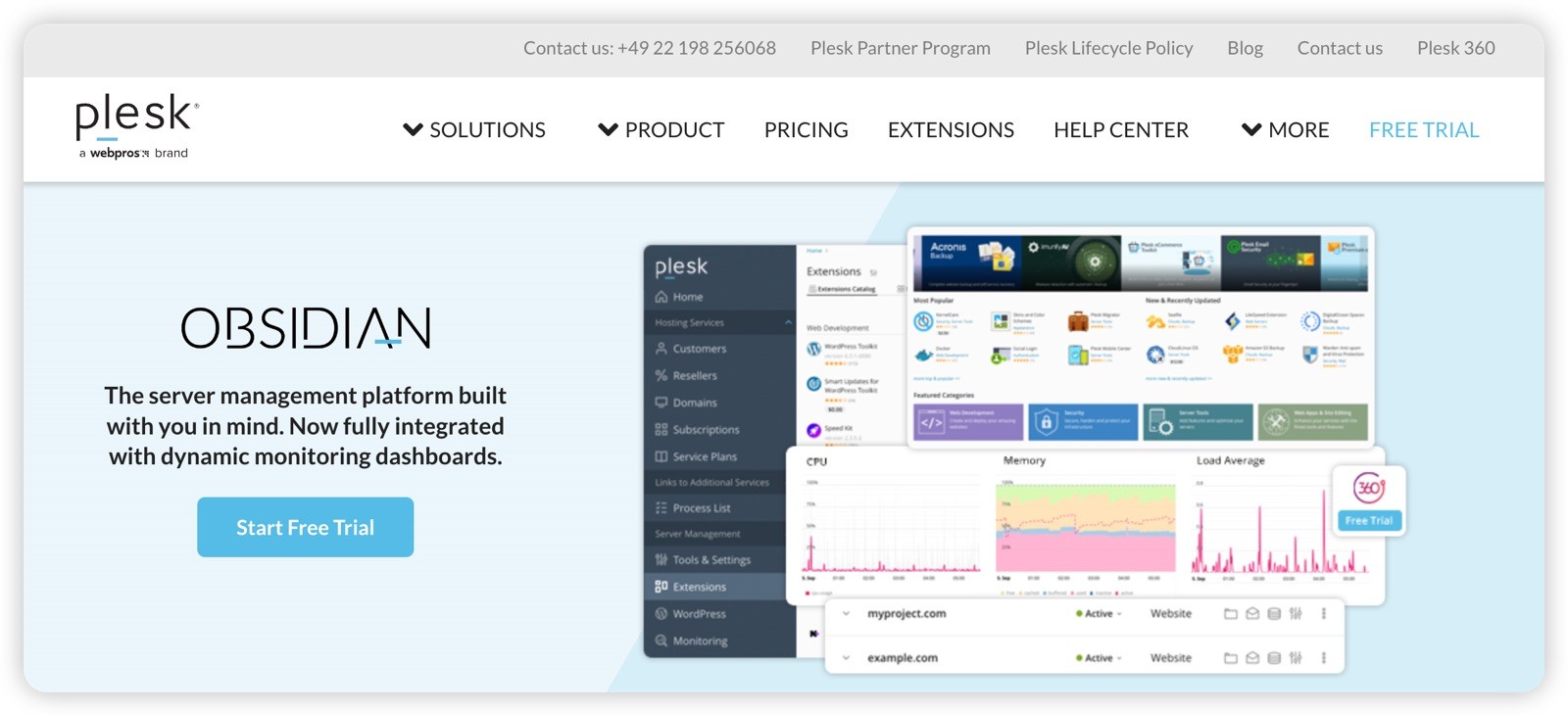
Here are the Key Features of Plesk:
- Website Management: Plesk offers easy website creation, management, and deployment tools. Users can set up domains, subdomains, email accounts, FTP access, and manage files through the file manager.
- Server Management: Plesk allows users to manage server resources, monitor performance, and configure settings such as PHP, Apache, Nginx, and other server components.
- Application Support: It supports a wide range of applications and content management systems (CMS) like WordPress, Joomla, Drupal, and more, with one-click installation and automated updates.
- Security: Plesk includes security features such as SSL/TLS certificate management, firewall configuration, and security scanning to help protect websites and servers from potential threats.
- Database Management: Plesk facilitates the management of MySQL and PostgreSQL databases, allowing users to create, modify, and back up databases easily.
- Collaboration Tools: It enables users to create and manage email accounts, calendars, and contacts, making collaboration and team communication suitable.
- Backup and Restore: Plesk provides backup and restore functionalities, allowing users to create regular backups of their websites and server configurations for data protection.
- Multi-Language Support: Plesk supports multiple languages, making it accessible to users worldwide.
Advantages of Plesk:
- User-Friendly Interface: Plesk's GUI is known for its user-friendly and intuitive design, making it easy for beginners and experienced users to manage websites and servers efficiently.
- Cross-Platform Support: Plesk supports various operating systems like Windows and Linux, providing flexibility in choosing the preferred hosting environment.
- Application Support: The ability to quickly deploy and manage popular applications through Plesk's one-click installer streamlines the website creation process.
- Security Features: Plesk's built-in security tools help users implement security best practices and safeguard their websites and servers.
- Regular Updates: Plesk is updated to provide bug fixes, security patches, and feature enhancements, ensuring a reliable and up-to-date hosting environment.
Disadvantages of Plesk:
- Cost: Plesk is not a free solution, and its licensing fees may add to the overall hosting expenses, particularly for smaller websites or personal projects.
- Resource Consumption: Like other control panels, Plesk may consume system resources, especially if hosting multiple websites, which could impact server performance.
- Learning Curve: While Plesk's interface is user-friendly, there can still be a learning curve for beginners new to web hosting and server management.
- Customization Limitations: Advanced users may find that specific configurations or customizations require manual intervention outside of Plesk, as some settings may not be exposed through the GUI.
- Compatibility Issues: Rarely, some web applications or scripts may work differently with Plesk due to compatibility issues.
Overall, Plesk is the best VPS control panel and influential web hosting control panel offering various features to streamline website and server management. It suits different users, from individuals managing personal websites to hosting companies handling multiple clients. However, users should consider their specific needs, technical expertise, and budget when choosing a control panel for their hosting environment.
Webmin
Webmin is a web-based system administration tool and the best VPS control panel that provides an easy-to-use graphical user interface (GUI) for managing Linux and Unix-like systems. It allows system administrators and users with the appropriate privileges to configure various aspects of the system through a web browser. Webmin simplifies the administration process, making it more accessible to users with limited command-line expertise.
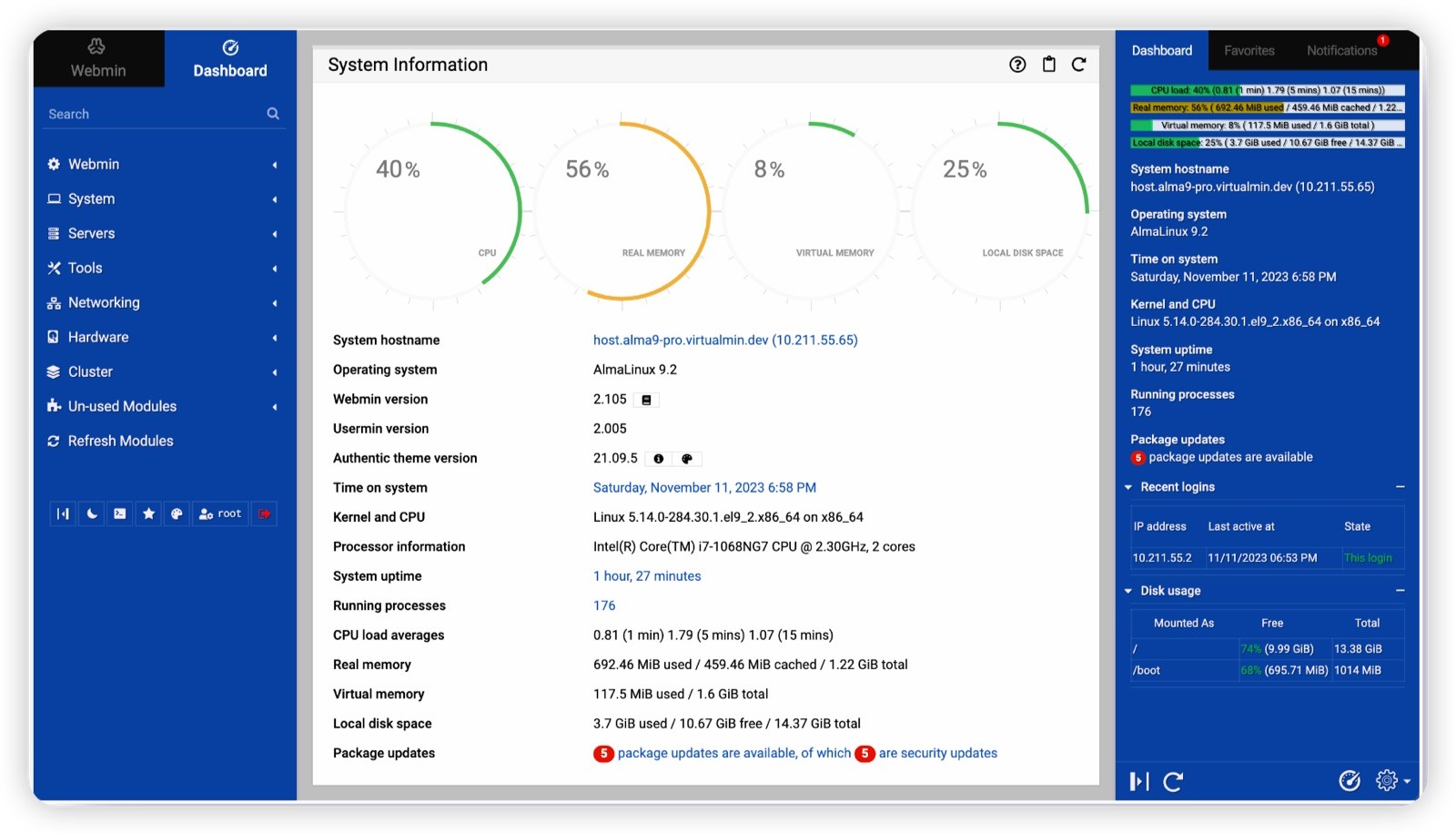
Here are the Key Features of Webmin:
- User and Group Management: Webmin allows administrators to manage user accounts, groups, and permissions on the system.
- Package Management: Administrators can easily install, update, and remove software packages using Webmin's package management module.
- File System and Disk Management: Webmin provides tools for managing files, directories, and disk partitions.
- Network Configuration: Administrators can configure network settings through the web interface, such as network interfaces, firewall rules, and routing tables.
- Services Management: Webmin enables administrators to start, stop, and configure various system services, including web servers, databases, and email servers.
- Backup and Restore: Webmin offers backup and restore functionalities for critical system files and configurations.
- Web Server Configuration: Administrators can configure web server settings, virtual hosts, and security options through Webmin.
Advantages of Webmin:
- User-Friendly Interface: Webmin's web-based interface makes system administration more accessible to users uncomfortable with the command-line interface.
- Cross-Platform Support: Webmin is compatible with various Linux distributions and Unix-like systems, making it versatile for different server setups.
- Comprehensive Features: Webmin covers many system administration tasks, providing a one-stop solution for managing Linux systems.
- Active Community: Webmin has a vibrant community of users and developers, leading to frequent updates, bug fixes, and new modules.
Disadvantages of Webmin
- Security Risks: Webmin allows system configuration through a web interface, introducing potential security risks if not adequately secured. Regular updates and security audits are essential to mitigate these risks.
- Limited Customization: While Webmin covers many aspects of system administration, it may offer a different level of customization and fine-tuning that can be achieved through manual command-line configuration.
- Resource Usage: Running Webmin consumes system resources, including memory and CPU, which could concern low-resource systems.
Overall, Webmin is a valuable tool for simplifying system administration tasks and providing a graphical alternative to the command-line interface. It can benefit administrators who prefer a GUI and must perform routine tasks quickly. However, careful attention should be paid to security measures to ensure the safe operation of the system when using Webmin.
ISPConfig
ISPConfig is a powerful and user-friendly web hosting control panel and the best VPS control panel that empowers website administrators and hosting providers to manage their servers and websites effortlessly. With its intuitive interface, ISPConfig simplifies complex server configurations, allowing you to focus on delivering an outstanding web hosting experience to your clients.
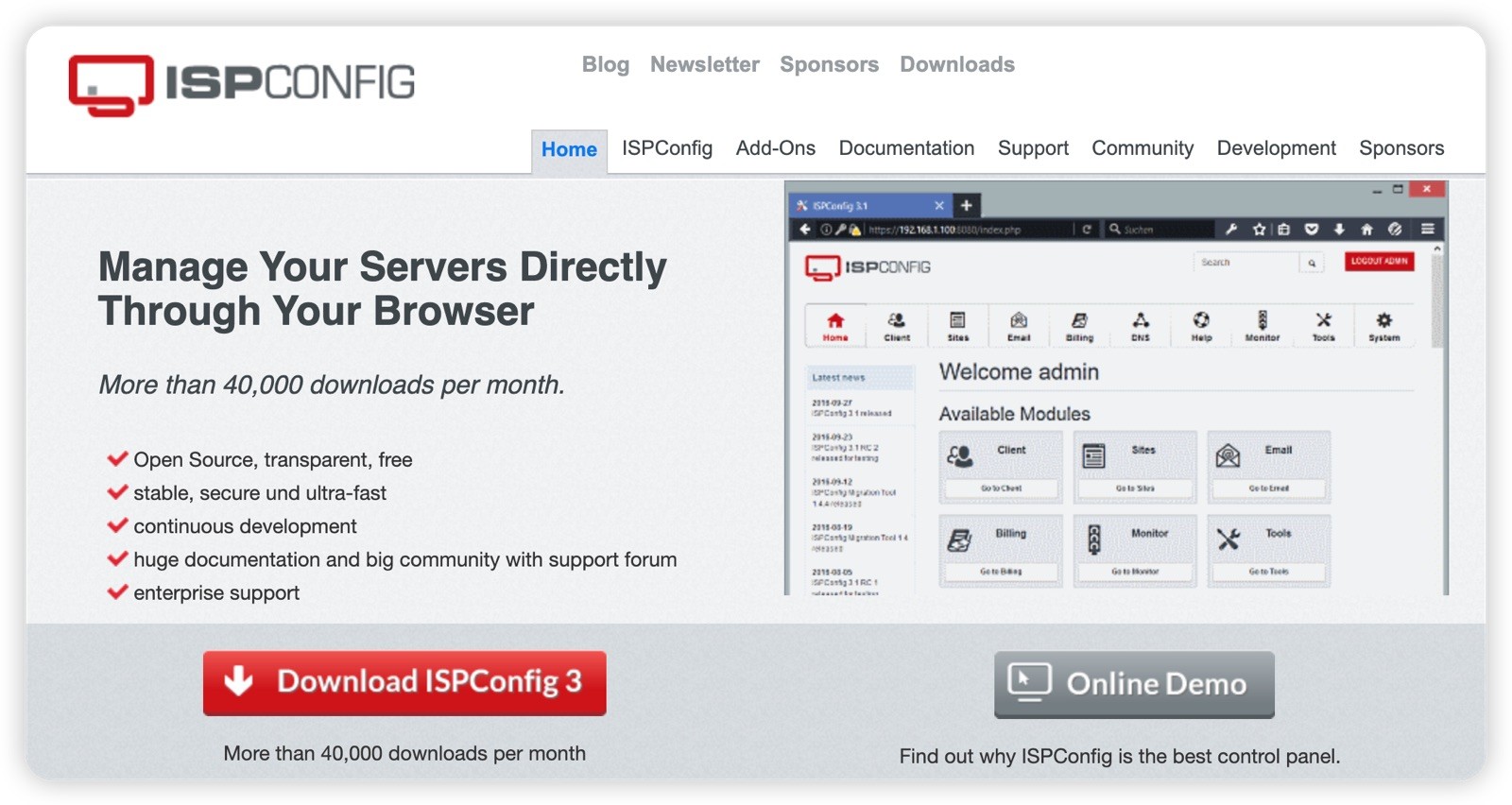
Here are the Key Features of ISPConfig:
- Easy Website Management: Create, edit, and delete websites with just a few clicks. Effortlessly manage domains, subdomains, and email accounts to keep everything organized.
- Email Management: Set up and easily manage email accounts, aliases, and forwarders. Enjoy secure POP3, IMAP, and SMTP configurations for seamless communication.
- Database Control: Create and administer MySQL and PostgreSQL databases, granting users complete control over their data storage requirements.
- FTP and File Management: Manage file access and permissions through FTP, SFTP, or the integrated web-based File Manager, making content updates a breeze.
- DNS and Firewall Configuration: Effortlessly configure DNS records and set up firewalls to protect your server and client data from potential threats.
- Reseller and Client Management: ISPConfig offers multi-level access controls, allowing resellers and clients to manage their hosting accounts autonomously.
Advantages of ISPConfig:
- Intuitive Interface: ISPConfig's user-friendly design makes server management accessible to novices and experienced administrators, reducing the learning curve.
- Open-Source and Free: As open-source software, ISPConfig is freely available, eliminating licensing costs and promoting flexibility for customization.
- Versatility: ISPConfig supports various operating systems, including Linux distributions such as Debian, Ubuntu, CentOS, and Fedora, ensuring compatibility with your preferred setup.
- Active Community: With a thriving user community and developers, ISPConfig benefits from regular updates, bug fixes, and new features.
Disadvantages of ISPConfig:
- Technical Knowledge Required: While ISPConfig streamlines server management, technical Knowledge may still be necessary for advanced configurations and troubleshooting.
- Scalability: While suitable for small to medium-sized hosting environments, larger enterprises require more robust control panel solutions.
In conclusion, ISPConfig is the best VPS control panel for administrators seeking a powerful, user-friendly control panel. Its intuitive interface and robust feature set make it an attractive option for efficiently managing websites, domains, email accounts, databases, and more. However, further evaluation of specific requirements may be needed for complex and highly scalable hosting environments.
🚀 Supercharge your website with lightning-fast performance! Get your own Virtual Private Server (VPS) hosting now and enjoy unbeatable speed, security, and flexibility. 💻🔒🔥
Webuzo VPS Hosting Control Panel
Webuzo VPS, Hosting Control Panel, is one of the best VPS control panels and a game-changer for web hosting management, offering a seamless and intuitive solution to deploy and manage virtual private servers (VPS) with unparalleled ease. With Webuzo, you can unleash the full potential of your VPS, delivering an exceptional hosting experience to your clients without the complexities.
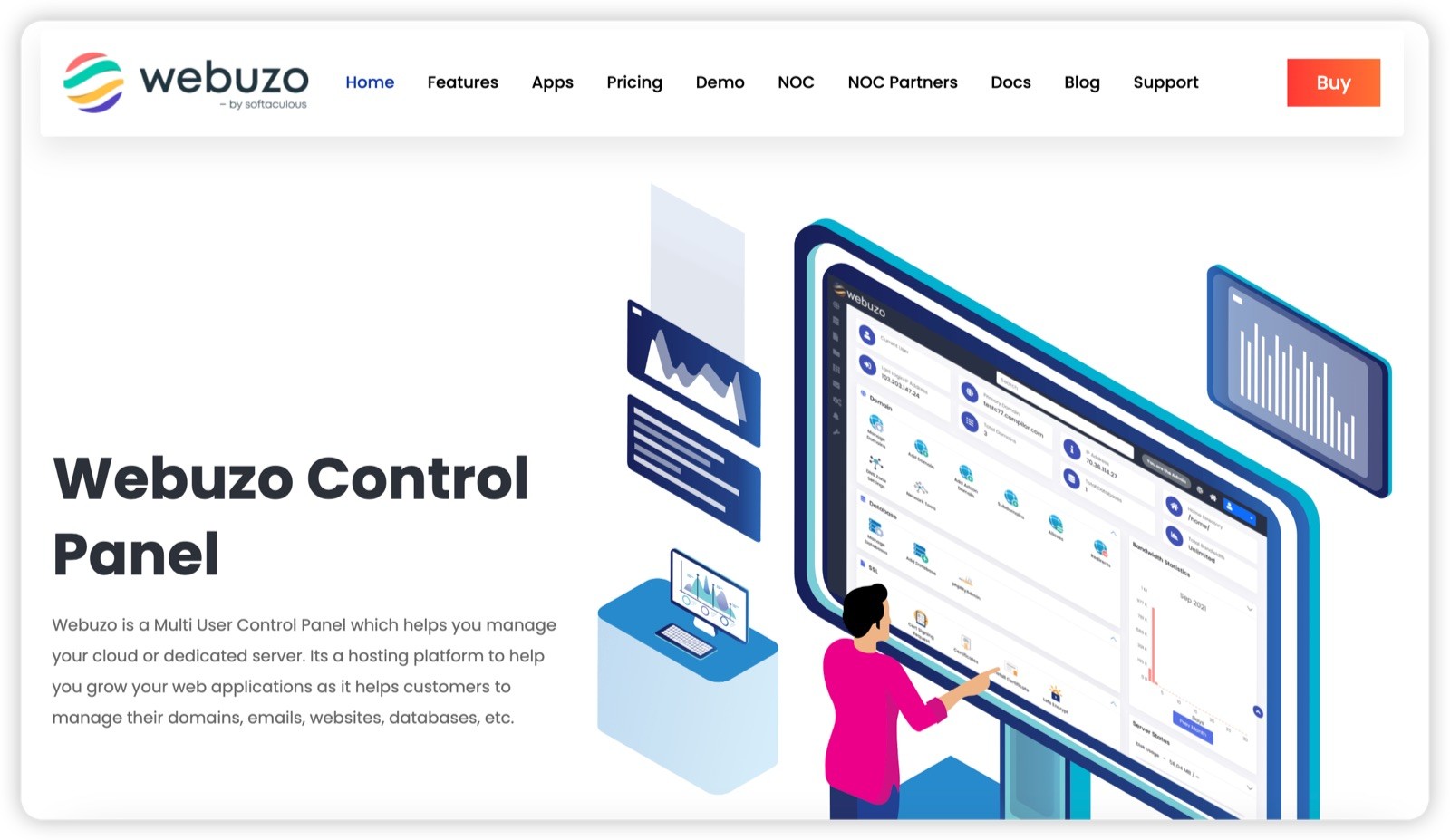
Here are the Key Features of Webuzo VPS:
- One-Click Installations: With a vast library of over 450 applications, Webuzo allows you to install popular software like WordPress, Joomla, and more with just one click.
- System Application Management: Enjoy complete control over Apache, Nginx, PHP, MySQL, and other system applications, enabling you to fine-tune server configurations perfectly.
- Multi-Domain Management: Host multiple domains on a single VPS easily, managing all websites efficiently from a centralized interface.
- Email and FTP Configuration: Set up email accounts, manage forwarders, and handle FTP accounts seamlessly, streamlining communication and file transfers.
- Robust Security Features: Webuzo provides firewalls, brute force protection, and SSL support to safeguard your server and client data from potential threats.
- Backup and Restore: Enjoy automated backups and restore points, ensuring the safety of critical data and providing peace of mind.
Advantages of Webuzo VPS Hosting Control Panel:
- User-Friendly Interface: Webuzo boasts an intuitive and visually appealing interface, making VPS management accessible even to those with limited technical expertise.
- Comprehensive App Library: The vast selection of one-click installable applications makes you effortlessly create diverse websites and applications.
- Resource Optimization: Webuzo is designed to consume minimal server resources, ensuring optimal performance and efficiency.
- Time-Saving Automation: Webuzo's automation capabilities minimize manual tasks, saving you valuable time managing your VPS hosting environment.
- Low-Cost Solution: Webuzo's affordability as a VPS control panel allows you to maximize profits without compromising functionality.
Disadvantages of Webuzo VPS Hosting Control Panel:
- Limited OS Compatibility: Webuzo is primarily designed for Linux-based VPS, limiting its usage to Windows-based server environments.
- Customization Constraints: While Webuzo is feature-rich, highly advanced and customized configurations might require additional manual adjustments.
In summary, Webuzo VPS Hosting Control Panel is one of the best VPS control panels, enabling you to harness the full potential of your server without the usual complexity. With its extensive application library, robust security features, and user-friendly interface, Webuzo empowers web hosting providers to deliver exceptional client services while optimizing server resources and saving valuable time. However, it is essential to consider OS compatibility and customization needs for specific use cases.
CentOS-WebPanel VPS Hosting Control Panel
CentOS-WebPanel VPS, Hosting Control Panel, is considered the best VPS control panel among many web administrators. It offers an all-in-one solution to effortlessly manage your Virtual Private Server (VPS) with unparalleled ease and efficiency. With CentOS-WebPanel, you can completely control your server and deliver an exceptional hosting experience to your clients without headaches.
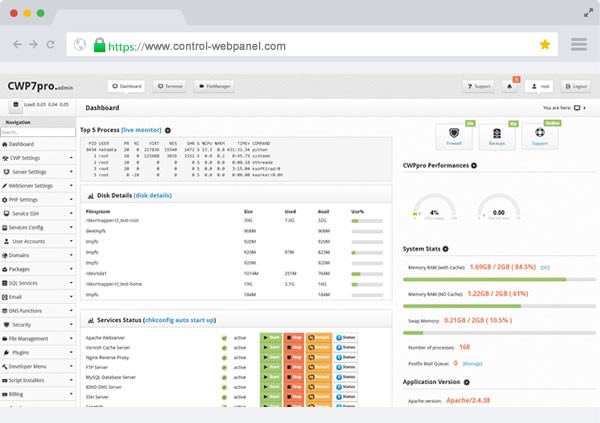
Here are the Key Features of CentOS-WebPanel VPS:
- Web Server Management: Take charge of Apache and Nginx settings with easy-to-use tools, ensuring optimal website performance and customization.
- PHP and MySQL Configuration: Fine-tune PHP versions and MySQL databases effortlessly, catering to the unique requirements of your applications.
- Email and DNS Management: Create email accounts, manage DNS settings, and handle domain configurations in one place, simplifying communication and domain setup.
- AutoSSL Integration: Boost security with AutoSSL integration, automatically obtaining and renewing SSL certificates for enhanced website protection.
- File Manager and FTP Access: Enjoy seamless file management through the web-based File Manager and FTP access, making content updates a breeze.
- One-Click Installer: Install popular applications like WordPress, Joomla, and more with a single click, enabling you to create diverse websites quickly.
Advantages of CentOS-WebPanel VPS Hosting Control Panel:
- User-Friendly Interface: CentOS-WebPanel boasts an intuitive and visually appealing interface, making VPS management accessible to beginners and experienced users.
- Robust Security Features: CentOS-WebPanel ensures top-notch server and client data security with integrated firewall and SSL support.
- Comprehensive Documentation: CentOS-WebPanel provides extensive documentation and a supportive community, making it easier for users to troubleshoot and learn.
- Automated Backups: Enjoy automatic backups and restore points, safeguarding critical data and offering peace of mind.
- Multi-Language Support: CentOS-WebPanel supports multiple languages, catering to users worldwide with diverse linguistic backgrounds.
Disadvantages of CentOS-WebPanel VPS Hosting Control Panel
- Limited OS Compatibility: CentOS-WebPanel is designed for CentOS-based VPS, which may limit its usage for servers running other operating systems.
- Advanced Customization: While CentOS-WebPanel offers many features, highly developed and customized configurations may require additional manual adjustments.
Finally, CentOS-WebPanel VPS Hosting Control Panel can be considered one of the contenders for our list of best VPS server control panels, empowering you to make the most of your server without the usual complexities. With its robust features, user-friendly interface, and comprehensive documentation, CentOS-WebPanel is the ideal solution for delivering exceptional hosting services to your clients while optimizing server resources and ensuring top-notch security. However, consider OS compatibility and specific customization needs when evaluating this control panel for your unique hosting environment.
Virtualmin VPS Hosting Control Panel
Virtualmin VPS, Hosting Control Panel, is the best VPS hosting control panel, a game-changing solution that puts the power of web hosting management at your fingertips. With Virtualmin, you can effortlessly deploy and manage your Virtual Private Servers (VPS) with unparalleled ease and efficiency, making it the ultimate choice for hosting professionals like you.
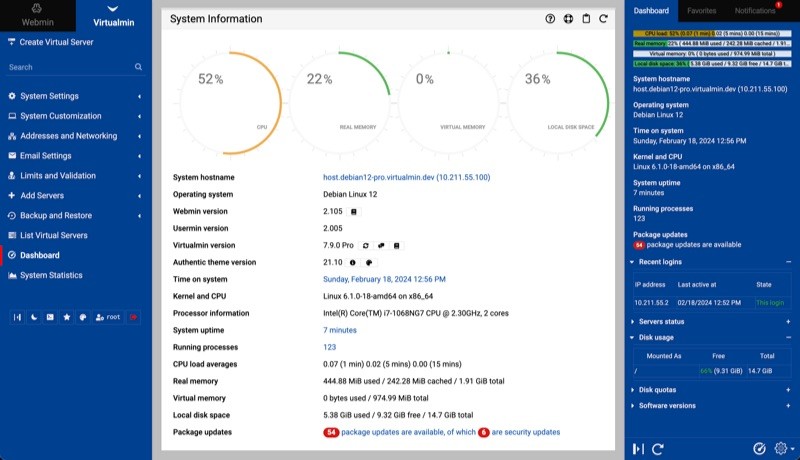
Here are the Key Features of Virtualmin VPS:
- Easy Website Management: Virtualmin simplifies website creation, management, and domain setup, allowing you to host multiple websites effortlessly.
- Automated Installations: With a vast library of one-click installable applications, Virtualmin lets you set up popular CMS software like WordPress, Joomla, and more quickly.
- Email and DNS Configuration: Set up email accounts, manage DNS settings, and easily handle domain configurations, streamlining communication and domain setup.
- Server Optimization: Fine-tune Apache, Nginx, PHP, and MySQL settings to ensure optimal website and application performance.
- Backup and Restore: Virtualmin provides automated backups and restore points, safeguarding critical data and ensuring peace of mind.
- SSL Integration: Boost website security with effortless SSL integration, enabling secure connections and enhanced protection.
Advantages of Virtualmin VPS Hosting Control Panel
- User-Friendly Interface: Virtualmin boasts an intuitive and visually appealing interface, making VPS management accessible to novices and seasoned administrators.
- Versatility: Virtualmin supports various Linux distributions, allowing you to choose your preferred operating system.
- Extensive Support: With an active community and comprehensive documentation, Virtualmin offers the support and resources to tackle any challenge.
- Resource Optimization: Virtualmin is designed to consume minimal server resources, ensuring optimal performance and efficiency.
- Cost-Effective: Virtualmin's affordability as a VPS control panel allows you to maximize profits without compromising functionality.
Disadvantages of Virtualmin VPS Hosting Control Panel:
- Limited OS Compatibility: Virtualmin primarily supports Linux-based VPS, limiting its usage to servers running other operating systems.
- Advanced Customization: While Virtualmin offers an extensive feature set, highly complex configurations may require additional manual adjustments.
In conclusion, Virtualmin VPS Hosting Control Panel is the ultimate solution for seamless VPS management, empowering you to harness your server's full potential easily. Its robust features, user-friendly interface, and extensive support resources make Virtualmin ideal for hosting professionals like you. However, consider OS compatibility and specific customization needs when evaluating this control panel for your unique hosting environment. With Virtualmin, you can deliver exceptional hosting services, optimize server resources, and take your hosting business to new heights.
Web Host Manager (WHM)
Web Host Manager (WHM) is the best VPS control panel and powerful web hosting control panel designed for web hosting providers and server administrators. This tool is one of the best free VPS control panels. With WHM, you can effortlessly manage multiple websites, and client accounts on your server, making it easier than ever to deliver top-notch hosting services.
Here are the Key Features of WHM:
- Account Management: WHM allows you to create, modify, and delete hosting accounts for your clients, giving you complete control over their hosting experience.
- Server Configuration: Fine-tune server settings and customize PHP, Apache, and other essential components to optimize server performance for your client's websites.
- Secure Hosting: WHM provides robust security features, including firewalls, SSL management, and brute-force protection, ensuring a secure hosting environment.
- Domain Management: Easily manage domain names, DNS zones, and subdomains, simplifying the process of setting up and maintaining client websites.
- Resource Allocation: Control and allocate server resources, such as disk space, bandwidth, and email accounts, to efficiently manage your hosting plans.
- Reseller Management: WHM allows you to create and manage reseller accounts, enabling you to offer hosting services to resellers and expand your business.
Advantages of Web Host Manager (WHM):
- Centralized Management: With WHM, you can manage all your hosting accounts and websites from a user-friendly interface, saving you time and effort.
- Scalability: WHM is designed to handle many hosting accounts and websites, making it an ideal solution as your hosting business grows.
- Custom Branding: WHM allows you to add your branding elements, such as logos and company information, giving your hosting business a professional look.
- Easy Migration: WHM simplifies the process of migrating websites from other hosting providers, ensuring a smooth transition for your clients.
- Support Resources: As a widely-used control panel, WHM benefits from a large community of users, developers, and extensive documentation, making it easy to find support and resources.
Disadvantages of Web Host Manager (WHM):
- Learning Curve: While WHM offers a user-friendly interface, it may still have a learning curve, especially for individuals new to server administration.
- Cost: WHM is a premium hosting control panel, and its licensing costs should be considered when evaluating it for your hosting business.
In conclusion, This tool is one of VPS's best control panels. Web Host Manager (WHM) is a comprehensive and reliable hosting control panel that empowers hosting providers and server administrators to manage their hosting environment with ease. With its extensive features, scalability, and security measures, WHM streamlines the hosting management process and enables you to offer top-quality hosting services to your clients. While there may be a learning curve and licensing costs to consider, the benefits and support resources make WHM an excellent choice for hosting professionals like you.
🌐 Discover the Top VPS Providers for Ultimate Performance 🌐
Looking to boost your website's performance and reliability? Explore our in-depth guide on the best VPS providers and choose the perfect solution tailored to your needs. Don't settle for less—find the best VPS for your site today!
Why Do You Need a VPS Control Panel?
This section explains the importance of using the best VPS control panels. A VPS (Virtual Private Server) Control Panel offers several compelling reasons why it's beneficial and often essential for managing a VPS hosting environment. Here are some key reasons why you need a VPS Control Panel:
- Server management: Users can start, stop, and restart their VPS, which gives them control over the server's availability and power status.
- OS installation: Users can often choose from various operating systems and initiate installation with just a few clicks.
- Resource monitoring: VPS Control Panels usually display real-time CPU, RAM, and disk usage statistics, allowing users to monitor their server's performance.
- File management: Users can access and manage their server's files through a built-in file manager or FTP (File Transfer Protocol) support.
- Domain and DNS management: Users can add and manage domain names associated with their VPS and configure DNS settings.
- Security settings: VPS Control Panels typically offer tools for managing firewall rules, setting up secure SSH access, and configuring security certificates (SSL/TLS).
- Backup and restoration: Users can create backups of their VPS and restore them when needed, providing an extra layer of data protection.
- Application installation: Some VPS Control Panels offer one-click installations for popular applications like WordPress, Joomla, or other content management systems.
- User-friendly Interface: Best VPS control panels provide a user-friendly web-based interface that simplifies server management tasks. Even with little technical knowledge, you can efficiently perform various administrative actions, such as starting or stopping your VPS, managing files, and installing applications.
- Server Management Made Easy: You can manage your virtual server without complex command-line interactions with the best VPS control panels. Tasks like OS installation, resource monitoring, and backup management become straightforward and can be accomplished with just a few clicks.
- Time Efficiency: Using a VPS Control Panel saves time and effort, especially for those who need to become more familiar with command-line interfaces. Everyday server management tasks can be completed quickly, allowing you to focus on other aspects of your projects or business.
- Centralized Control: Best VPS control panels offer a centralized hub to manage all aspects of your VPS. You can handle various settings and configurations from a single dashboard, making it convenient and efficient to oversee your server.
- Security Management: Many VPS Control Panels come with security features that help protect your server from potential threats. These features often include firewall management, SSH key management, and SSL certificate installation.
- Resource Monitoring: Best VPS control panels typically provide real-time resource usage statistics, allowing you to monitor CPU, RAM, and disk usage. This information helps you make informed decisions about your server's performance and potential optimizations.
- Domain and DNS Management: Managing domain names and DNS settings can be done quickly within the Control Panel. You can effortlessly add, modify, or remove domain names associated with your VPS.
- Application Installation: The best VPS control panels offer one-click installations for popular web applications, content management systems, and databases. This simplifies setting up websites or web services on your VPS.
- Backup and Restore: Best VPS control panels often include backup and restoration tools, enabling you to create regular backups of your server's data. In the event of data loss or server issues, you can quickly restore your VPS to a previous state.
- Accessibility: As the best VPS control panels are web-based, you can access and manage your VPS from anywhere with an internet connection. This flexibility allows you to take care of server-related tasks on the go.
Best VPS control panels streamline VPS management, make it accessible to a broader audience, and provide essential tools for efficient server administration. Whether you are a website owner, developer, or a business looking to host applications, a VPS Control Panel can significantly enhance your hosting experience and help you get the most out of your virtual server.
What To Consider When Looking for a VPS Control Panel?
When choosing the best VPS control panels, several essential factors must be considered to ensure that it meets your needs and provides a smooth and efficient management experience. Here are the key considerations:
User Interface and Ease of Use
The best VPS control panels should have a user-friendly interface that is easy to navigate and understand. Look for a demo or trial version to test the interface before committing to a specific Control Panel.
Feature Set
Evaluate the features offered by the Control Panel. It should include essential functionalities such as server management, resource monitoring, domain and DNS management, security settings, backup and restoration options, and application installation support. Ensure it covers all the tasks you need to manage your VPS effectively.
Operating System Compatibility
Make sure the Control Panel is compatible with the operating system running on your VPS. Some Control Panels are optimized for specific operating systems (e.g., Linux or Windows), so choose one that aligns with your server's OS.
Security Features
Security is crucial for any server. Look for a Control Panel that offers robust security features, such as firewall management, SSH key management, SSL certificate installation support, and access control settings.
Resource Requirements
Consider the resource requirements of the Control Panel itself. Some Control Panels might consume more system resources, which can impact the performance of your VPS. Ensure that your server has sufficient resources to run the Control Panel smoothly.
Customization and Flexibility
Assess how much customization the Control Panel allows. You may need to tailor specific settings to your requirements, so a flexible Control Panel is advantageous.
Support and Documentation
Check the availability of documentation, guides, and tutorials for the Control Panel. A well-documented Control Panel makes troubleshooting issues and learning about its features easier. Also, consider the level of support provided by the Control Panel's developers or the hosting company.
Community and User Feedback
Look for user reviews and feedback from the district. This will give you insights into real-world experiences and potential issues others have encountered with the Control Panel.
Integration with Hosting Providers
If you purchase VPS hosting from a specific provider, determine if they offer proprietary Control Panels. These may be tailored to their infrastructure and provide seamless integration with their services.
Scalability
Consider whether the Control Panel can handle multiple VPS instances if you plan to expand your hosting setup. Scalability is essential to manage multiple servers from a single interface.
Cost
Different VPS Control Panels come with varying pricing models. Some may be offered for free, while others have licensing fees. Evaluate the price of the features and value it provides to determine if it fits your budget.
By carefully considering these factors, you can choose the best VPS control panels that align with your requirements, enhances your server management experience, and facilitates the smooth operation of your virtual private server.
Conclusion
In conclusion, the best VPS control panels offer a wide range of powerful features that streamline server management and enhance the hosting experience for both hosting providers and administrators. Each control panel has unique strengths, making it suitable for different user preferences and hosting environments.
cPanel is the best VPS control panel, popular with its user-friendly interface, comprehensive features, and extensive community support. Its ease of use and automation capabilities make it an excellent option for beginners and experienced users.
Plesk is another top contender, offering a versatile solution supporting multiple operating systems and a rich ecosystem of extensions. Its focus on security and ease of website management makes it an attractive option for hosting providers.
Webmin provides a powerful and customizable option with many features for those seeking open-source solutions. Its ability to manage various server components and its active community suit those looking for flexibility and control.
CentOS-WebPanel and Virtualmin cater to users who prefer lightweight control panels. While CentOS-WebPanel focuses on ease of use and automation, Virtualmin offers extensive support and resources for Linux-based VPS environments.
Lastly, WHM and Webuzo are compelling choices, with WHM being a comprehensive solution tailored for hosting providers and resellers, while Webuzo offers a simplified experience for individuals managing their VPS.
Ultimately, the best VPS control panel for you will depend on your specific hosting requirements, technical expertise, and budget. Each control panel presented has unique advantages and disadvantages, enabling you to decide based on your hosting business needs. Whether you prioritize ease of use, customization, or security, these top VPS control panels ensure you have the tools to deliver outstanding hosting services and create a seamless experience for your clients.

I'm fascinated by the IT world and how the 1's and 0's work. While I venture into the world of Technology, I try to share what I know in the simplest way with you. Not a fan of coffee, a travel addict, and a self-accredited 'master chef'.